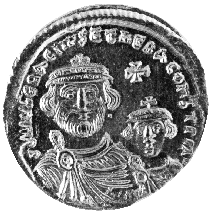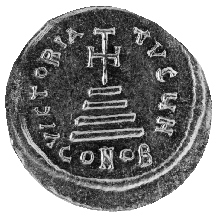



(135) Heraclius and Heraclius Constantine - AV solidus, A.D. 613-625,
4.44 g. (inv. 91.275).
Obverse: Facing bust of Heraclius with beard on l., facing bust of Heraclius
Constantine on r., each wearing chlamys and crown with cross; cross
in field between heads; DD (DOMINI abbreviated) NN(NOSTRI abbreviated) HERACLIVS
ET HERA(CLIVS) CONST(ANTINVS) P(ER)P(ETVI) AV(GVSTI): Our lords Heraclius
and Heraclius Constantine, perpetual Augusti.
Reverse: Cross potent on steps; VICTORIA AVCV(STI) H: Victory of Augustus,
officina mark H; in exergue, CONOB: gold of Constantinople.
Provenance: Hesperia Art, 1959.
Bibliography: W. Wroth, Catalogue of the Imperial Byzantine Coins in
the British Museum (London 1908) 28; P. Grierson, Byzantine Coins
(London 1982).
Heraclius overthrew his hated predecessor, Phocas, in A.D. 610. He regained
much of the territory that had been lost by his predecessors and ensured
stability by re-establishing the practice of adopting an heir who ruled
in association with him. His eldest son, Heraclius Constantine, was made
Augustus soon after he was born.
The obverse of this solidus of Heraclius proclaims his intention to rule
jointly with his son and establishes the conventions of coin portraits for
joint rulers. Heraclius as the senior ruler is depicted on the left, with
the junior Heraclius Constantine on the right. Differences in scale underscore
the differences in age and seniority, as does the fact that Heraclius Constantine
has not yet acquired a beard. The chlamys worn by the two figures
is civilian garb and in most emperor portraits of the seventh century replaces
the armor of earlier emperors. It was a long, embroidered purple cloak,
fastened on the right shoulder by a fibula or pin, which in imperial
portraits takes the form of a round brooch with three pendants.
The reverse revives the cross on the steps, a type introduced by Tiberius
Constantine (see no. 133), understood to represent the cross on the hill
of Calvary; it would become the main reverse type of the seventh century.
R.K.B.



All contents copyright (c) 1996.
Lawrence University
All rights reserved.